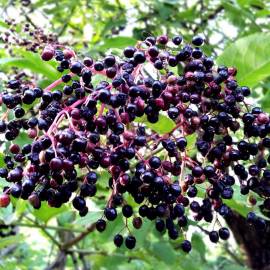







Black Chokeberry Seeds (Aronia melanocarpa)
1.39 €
A. melanocarpa can also be used as an edible fruit crop although the fruit is too astringent to eat raw. The fruit is used instead in baking and to make jams, jellies, syrup, tea, juice, and wine.
-
Black Chokeberry / Aronia Melanocarpa
Black chokeberry has two seasons of interest: spring and fall. Dark green glossy, finely-toothed 1-3" leaves form a backdrop for 2-3" clusters of flowers in spring. The white five-petaled flowers have showy pink anthers. Flowers are followed by clusters of ¼ to ½" fruit that turn purplish-black or black in late summer and autumn. In autumn, leaves change from green to vibrant tones of red, orange, and purple.
Black chokeberry is an adaptable tough shrub because of its hardiness and wide tolerance to a variety of soil textures, densities, pH levels, and moisture conditions. In cultivated landscapes, where chokeberries have less competition and receive more fertility and care, they become strongly suckering plants. Because of suckering and its tolerance to wet soils, this species is typically used in mass planting, in naturalized and woodland gardens, for erosion control, in windbreaks, and in landscapes with excessively wet soils. Fruit can persist into winter and serves as a food source for birds and mammalian wildlife.
A. melanocarpa can also be used as an edible fruit crop although the fruit is too astringent to eat raw. The fruit is used instead in baking and to make jams, jellies, syrup, tea, juice, and wine. Black chokeberry now ranks high among health foods because its blueberry-sized fruit possess the highest level of antioxidants among temperate fruit species.
Problems
No serious insect or disease problems. Some susceptibility to leaf spots and twig/fruit blight.
Garden Uses
Group or mass in shrub borders, small gardens or open woodland areas. Ability to withstand wet conditions makes it suitable for growing on the margins of ponds or streams. Excellent addition to naturalized areas where its suckering, colonial growth habit does not need to be restrained.
